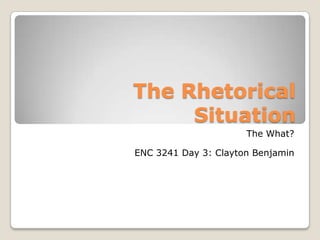
Enc lecture day3
- 1. The Rhetorical Situation The What? ENC 3241 Day 3: Clayton Benjamin
- 2. What is Rhetoric? “The art of persuasion.” More broadly: “The newer sense of “rhetoric” implies that whenever humans communicate with other humans, they seek to elicit any number of responses ranging from understanding to emotional reaction to agreement to enlightenment or any one of almost limitless reactions,”OWL Purdue
- 3. What is the “Rhetorical Situation?” Elements: ◦ Author: ◦ Text ◦ Context ◦ Audience
- 4. Author Someone who uses communication for a purpose. ◦ Eg: entertain, perform, persuade, educate, instruct, sadden, punish... Factors of authorship: ◦ Age ◦ Income ◦ Expertise ◦ Location
- 5. Text The medium/media used to disseminate the author’s intention. ◦ Eg: TV commercial, instruction manual, speech, email, letter, book, YouTube video, Prezi, PowerPoint, etc.
- 6. Context The situation in which the “writing” is taking place. ◦ Eg: Time, Place, Culture, Online/Offline, Current Events…
- 7. Audience The people who will see or hear the message. Audience factors ◦ Socio-Economic Status ◦ Knowledge/Expertise/Education/Subject Familiarity ◦ Political/Religious views ◦ Age ◦ Language ◦ Expectations
- 9. Applying Rhet Situation In Tech Comm User Centered Design: design your documents around your user (audience)! Who is your audience? What prompted the need for the information you need to communicate? (purpose) Who are you? (author) Which medium should be used to effectively communicate? (text)
- 10. Due Next Time: Read Chapter 2!
